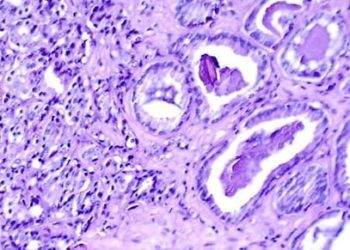Retired NFL players are at increased risk of death due to neurodegenerative disease
Image: PD
Key study points:
- Death due to neurodegenerative disease was significantly more common in a cohort of NFL players in comparison to the general United States male population, particularly among players in speed positions.
- These results support the evolving understanding of Chronic Traumatic Encephalopathy as a cause of death in former NFL players.
Primer: Chronic traumatic encephalopathy (CTE) is a disorder that has garnered widespread public interest in recent years, due in part to a number of high-profile suicides involving players in the National Football League (NFL). However, central nervous system (CNS) sequelae have been recognized to be associated with repeated head injury since early last century. Originally coined dementia pugilistica, the syndrome of being “punch drunk” that appeared in boxers manifested primarily with impaired mentation and motor symptoms. With increasing interest from the medical community came the realization that this syndrome was not unique to boxers, but rather could result from nearly any exposure to traumatic brain injury (TBI), perhaps even in the absence of frank concussion or loss of consciousness. Moreover, a much wider range of symptoms stemming from progressive neurodegeneration has since been described. Early presenting symptoms may include short-term memory problems, executive dysfunction, and psychiatric disturbance including suicidality. Later in the disease course, patients develop frank dementia, apathy, behavioral disturbances, and parkinsonian motor symptoms.
Based on continually growing databases of post-mortem specimens, investigators are elucidating the underlying pathophysiology of CTE. Gross pathologic features include generalized atrophy, as well as localized atrophy in the medial temporal lobes, mammillary bodies, and thalamus. Cells are lost in the substantia nigra and locus coeruleus, the sites in the brain where dopamine and norepinephrine are respectively produced. Microscopically, deposits of tau-reactive neurofibrillary tangles (NTs) and beta-amyloid deposits are found in numerous brain structures, though in a distribution distinct from that seen in Alzheimer’s dementia.As CTE becomes more widely recognized and better understood, increasing attention is being focused on its incidence among cohorts at risk, particularly NFL players. As the authors note, CTE is not currently recognized as an official cause of death in the International Classification of Diseases (ICD) system, and therefore, the study instead examined the incidence of mortality in NFL players secondary to neurodegenerative diseases, which may all fall under the symptomatic spectrum of CTE.
Background reading:
- Stern RA, et al. (2011) Long-term consequences of repetitive brain trauma: chronic traumatic encephalopathy. Phys Med Rehabil Clin N Am 22:603-670.
- McKee A, et al. (2009) Chronic Traumatic Encephalopathy in Athletes: Progressive Tauopathy following Repetitive Head Injury. J Neuropathol Exp Neurol 68(7):709-35.
This [retrospective cohort] study: The authors examined causes of death in a group of 3,439 NFL athletes who played at least five seasons between 1959 and 1988. The cause of death for the 334 of these players who are currently deceased was determined. Neurodegenerative disease was defined as dementia, amyotrophic lateral sclerosis (ALS), and Parkinson disease. These players were also stratified by into speed (quarterback, running back, wide receiver, tight end, safety, defensive back, cornerback) and non-speed (offensive and defensive lines) positions. Punters and kickers were excluded.
In comparison to causes of death for the general United States male population, neurodegenerative disease mortality was 3 times more common in NFL players at 3 percent. Increased mortality was also observed in each subcategory of neurodegenerative disease, though this was only significant for dementia and ALS (each four times more common). While neurodegenerative mortality remained more common in players after stratification for position, it was only statistically significant for players of speed positions.
In sum: Neurodegenerative disease as a cause of death was found to be significantly more common among NFL players than the United States male population as a whole, particularly dementia/Alzheimer’s disease and ALS. While chronic traumatic encephalopathy cannot be definitely implicated in any of these players in the absence of brain pathology findings, the authors note that it may likely be the primary or secondary pathology in the causes of neurodegenerative disease they included in their analysis.
This study was limited by a relatively small number of deaths (334), particularly those due to neurologic disease. As the authors recognize, this prevented them from more detailed stratification of the cohort. Also, though the results implicated high-speed deceleration in the pathogenesis of CTE, more detailed insight into the mechanisms of the disease need to be examined in future studies. Regardless, these results confirm the increased incidence of neurodegenerative disease in NFL players, underscoring the importance of continued investigation into the epidemiology and pathogenesis of CTE. This research is part of a larger body of evidence which may have a profound effect in the future on professional football, as well as have wide-reaching implications for athletes, soldiers, and others exposed to repeated head trauma.
Click here to read the study in Neurology
By [JD] and [RR]
© 2012 2minutemedicine.com. All rights reserved. No works may be reproduced without written consent from 2minutemedicine.com. DISCLAIMER: Posts are not medical advice and are not intended as such. Please see a healthcare professional if you seek medical advice.




